Generic hyper-diversity in Stachybotriaceae
- PMID: 27616791
- PMCID: PMC4988370
- DOI: 10.3767/003158516X691582
Generic hyper-diversity in Stachybotriaceae
Abstract
The family Stachybotriaceae was recently introduced to include the genera Myrothecium, Peethambara and Stachybotrys. Members of this family include important plant and human pathogens, as well as several species used in industrial and commercial applications as biodegraders and biocontrol agents. However, the generic boundaries in Stachybotriaceae are still poorly defined, as type material and sequence data are not readily available for taxonomic studies. To address this issue, we performed multi-locus phylogenetic analyses using partial gene sequences of the 28S large subunit (LSU), the internal transcribed spacer regions and intervening 5.8S nrRNA (ITS), the RNA polymerase II second largest subunit (rpb2), calmodulin (cmdA), translation elongation factor 1-alpha (tef1) and β-tubulin (tub2) for all available type and authentic strains. Supported by morphological characters these data resolved 33 genera in the Stachybotriaceae. These included the nine already established genera Albosynnema, Alfaria, Didymostilbe, Myrothecium, Parasarcopodium, Peethambara, Septomyrothecium, Stachybotrys and Xepicula. At the same time the generic names Melanopsamma, Memnoniella and Virgatospora were resurrected. Phylogenetic inference further showed that both the genera Myrothecium and Stachybotrys are polyphyletic resulting in the introduction of 13 new genera with myrothecium-like morphology and eight new genera with stachybotrys-like morphology.
Keywords: biodegraders; generic concept; human and plant pathogens; indoor mycobiota; multi-gene phylogeny; species concept; taxonomy.
Figures

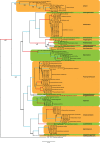
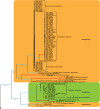












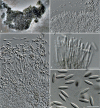















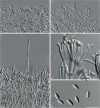




































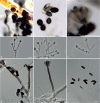















References
-
- Abbas HK, Johnson BB, Shier WT, et al. 2002. Phytotoxicity and mammalian cytotoxicity of macrocyclic trichothecene mycotoxins from Myrothecium verrucaria. Phytochemistry 59: 309–313. - PubMed
-
- Agarwal SC. 1980. A new species of Myrothecium from Indian alkaline soils. Current Science 49: 281–282.
-
- Alves JL, Barreto RW, Pereira OL. 2010. Additions to the mycobiota of the invasive weed Miconia calvescens (Melastomataceae). Mycologia 102: 69–82. - PubMed
-
- Amagata T, Rath C, Rigot JF, et al. 2003. Structures and cytotoxic properties of trichoverroids and their macrolide analogues produced by saltwater culture of Myrothecium verrucaria. Journal of Medical Chemistry 46: 4342–4350. - PubMed
-
- Andersen B, Nielsen KF, Thrane U, et al. 2003. Molecular and phenotypic descriptions of Stachybotrys chlorohalonata sp. nov. and two chemotypes of Stachybotrys found in water-damaged buildings. Mycologia 95: 1227–1238. - PubMed
LinkOut - more resources
Full Text Sources
Other Literature Sources
Molecular Biology Databases
